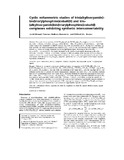Cyclic voltammetric studies of tris(alkylisocyanide)-bis(triarylphosphine)cobalt(II) and tris-(alkylisocyanide)bis(triarylphosphine)cobalt(I) complexes exhibiting synthetic interconvertability

View/
Date
2003Author
Ahmad, J.
Bothata-Nareetsile, F.
Becker, C.A.L.
Publisher
NRC Research Press, http://www.nrcresearchpress.com/loi/cjcType
Published ArticleMetadata
Show full item recordAbstract
Nine pairs of corresponding [CoI(CNR)3(PR3 ′ )2]X, [CoII(CNR)3(PR3 ′ )2]X2 complexes — where X = ClO4,
BF4; CNR = CNCMe3, CNCHMe2, CNC6H11, CNCH2Ph; PR3′ = PPh3, P(C6H4Me-p)3, P(C6H4OMe-p)3 — have been studied using cyclic voltammetry in CH3CN solutions. All cycles are reversible, and E1/2 for the Co(I) complexes, initially
oxidized, are within experimental error identical to E1/2 values for the corresponding Co(II) complexes, initially reduced. E1/2 values are strongly dependent on the triarylphosphine ligand, decreasing in the order PPh3 > > P(C6H4Me-p)3 > P(C6H4OMe-p)3, and weakly dependent on the alkylisocyanide ligand, decreasing in the order
CNCH2Ph > CNCMe3 > CNC6H11 ≥ CNCHMe2. Solution ν(-N C) IR patterns reveal that the [CoI(CNR)3(PR3′)2]X
complexes do not have regular trigonal bipyramidal coordination, their structure being determined by the particular CNR ligand, while the [CoII(CNR)3(PR3′)2]X2 complexes, specifically in CF3CH2OH, appear to have regular trigonal
bipyramidal coordination.
